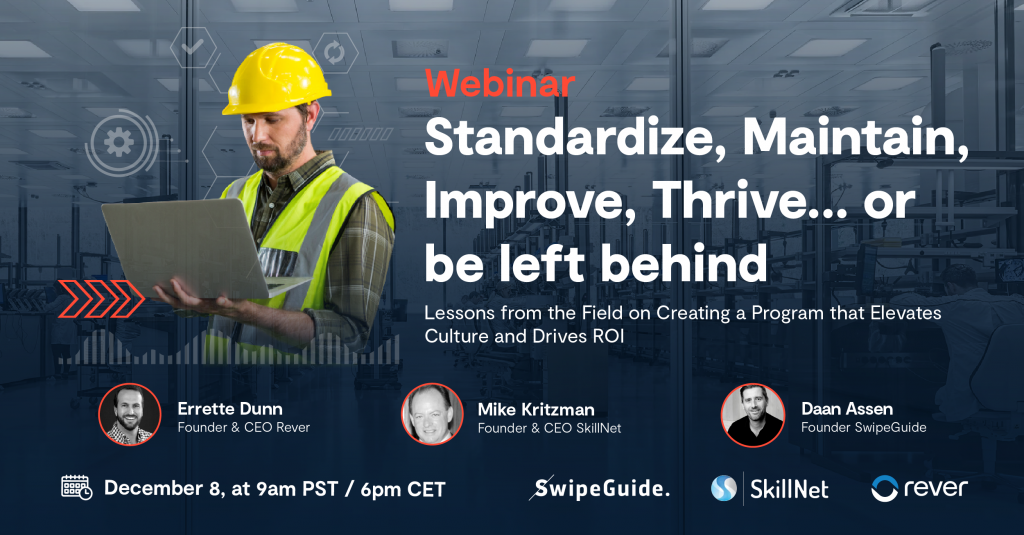Series (4/6): Building and Managing Skills
6 minutes, 40 seconds read

Learn more about, and connect with, our presenters on LinkedIn:
Errette Dunn, Founder & CEO Rever (learn more about Rever)
Daan Assen, C0-founder SwipeGuide (learn more about SwipeGuide)
Mike Kritzman, Founder & CEO SkillNet (learn more about SkillNet)
Host: Ralf VonSosen, Chief Solution Office, Rever
In this segment, we look into the development of skills and how to make sure that both individuals and companies experience the benefit of that development.
Watch here! See the live discussion.
Ralf VonSosen:
Identifying the right individuals with the right skills. How do you make sure that you have the right individuals with the right skills, and how do you identify them at the right time when you need those individuals?
Mike Krizman:
We start by defining the functional and technical requirements of the role. So once we know what’s expected, then we measure how this person is doing against that set of objectives. At the frontline, this is typically done by a trainer or supervisor making observations of that worker. How are they doing in loading the machine or welding ,or whatever the job might be. Once they have reached proficiency or maybe have become so good that they can show others how to do it, we recommend creating a certification for doing that operation.
Centralizing these ratings to a database and putting them in a dashboard shows who is certified or proficient for each operation. This creates a roster of capabilities of people who know how to do things and identifies where they are during the proficiency climbing while they’re developing these skills. Access to tools like SwipeGuide for standard work instructions and shared best practices can be big accelerators, to developing the required capabilities to work on the shop floor. Clarity around what’s expected and then creating training resources, positive reinforcement of their progress, that pat on the back that says “hey, you’re doing good” are critical. Certifications help the individual and the company,
Ralf VonSosen:
Daan, is that something that you see that goes hand in hand with digitizing, formalizing, and reforming standards?
Daan Assen:
Yes. We see that in a lot of cases, digital standard work is perfect material for on the job training. When I look at what we do with SwipeGuide and the content that sits in our platform at a company like Heineken, it is used globally to train people on the job. That makes total sense because we’re not in an age where you can put these people in a classroom for five days to train them on how stuff actually works on the shop floor. They need to be on the shop floor. They need to have their standards available there with their supervisor or on-job-trainer to go over them and reach a proficiency level. That’s where it ties into what Mike is doing with SkillsNet. You need to have a place to manage the certifications.
You want to keep a record of those certifications. A company like Heineken wants to keep records of who did what, with which work instructions to gain which level of proficiency. That can be a level of ticking a box, “Yes, I’m certified” up to a level where you have five different skills levels like beginner, advanced, expert, trainer, whatever. Of course this needs to be tracked. So we see a lot of combinations where people, once they build up their knowledge base, also want to connect that to their skills management information.
Ralf VonSosen:
The more qualified everybody is, the more prepared they are to look for new opportunities, to look for new ways of doing things, to recognize things that are out of standard and so forth. It’s a cycle, right. Sort of a positive acceleration. So let’s jump now from that into something that is a real acute, I need people, where do I find people? How do I retain the people that I have?
Mike Krizman:
It’s the career journey. Let’s talk about attracting talent. We all want to be a part of a company that will help us get better. Joining an organization with world class training capabilities will set the firm apart. Offering cross training so that individuals can expand and become more valuable is another differentiator. This concept of using training as a bargaining chip to attract talent is a key ingredient. Once you’ve hired them, how do you retain them? And turnover is really the worst outcome for companies because they went through the trouble to train people and then they lose them.
Everybody talks about this great resignation. So developing proficiency quickly and effectively is a key to retention. There’s a lot of research that developing people is a high priority. And this is especially true in the younger workforce who want to be capable in many areas. Also, who wants to go to work when they feel like they’re not good at what they’re doing. It is frustrating to go in and you feel like you’re not doing a good job. You’re not gonna stick, stick with it. I talked about this before, I’ll just say it again, giving someone a reward as a certification, it costs the company nothing, but it builds pride.
And that is a meaningful thing. They’re proud of the work they’re doing. It’s recognized that they’re good enough and that they’ve earned a certification, this stuff matters. Growth to me is training and building confidence in multiple areas to grow staff. This is great for retention. Not only for the individual, for the company because turnover is inevitable. If there is sick leave or someone is late to work because of traffic, knowing that you have multiple people who can get the job done is something that can easily be managed by having multiple people with capabilities to do these jobs.
Ralf VonSosen:
I think one of the things I’m gonna walk away from is nobody wants to go to a job where they don’t know if they’re good at it or not.
Errette Dunn:
I want to emphasize another thing that helps to attract and retain people, is treating them like the human beings that they expect to be treated. Unfortunately, many of these companies are hiring the perception of “frontline employees are a resource that’ll help me move things, assemble things”. Unfortunately that is a very dehumanizing view. So you shouldn’t be surprised if you then struggle to retain those people, when you view them that way. So what would people expect to have in their jobs? They want to be empowered to solve their own problems, to collaborate with others, to use interesting modern technologies as they do in their daily lives like social networks and WhatsApp. Empower them to use the same sort of things at work. Recognize them, besides their motor skills that you’re hiring them for, recognize their uniquely human attributes of being problem solvers and help them develop those skills. Both in training and on the job. Reward them for doing so.
Read more from this wonderful discussion:
- Adjusting Operations to the Ongoing Pandemic (1 of 6)
- Power of Standardization and Standard Work (2 of 6)
- Driving Continuous Improvement (3 of 6)
- Building and Managing Skills (4 of 6)
- Leveraging the Power of Technology (5 of 6)
- Advice for 2022 – It’s about your people (6 of 6)
OR, watch the Video Recordings (each is 5-10min in length):
- Adjusting Operations to the Ongoing Pandemic (1 of 6)
- Power of Standardization and Standard Work (2 of 6)
- Driving Continuous Improvement (3 of 6)
- Building and Managing Skills (4 of 6)
- Leveraging the Power of Technology (5 of 6)
- Advice for 2022 – It’s about your people (6 of 6)
Like this content? Sign up for our Newsletter
[hubspot type=form portal=561211 id=fda6d445-739e-4072-8dae-68b94971a266]THE FRONTLINE DOJO
More Articles
How to develop the next billion Knowledge Workers
3 minutes, 51 seconds read
Digital transformation in manufacturing is not what you think it is
10 minutes, 36 seconds read
The human side of change management: lessons learned from Toyota, Airbus, and Silicon Valley
1 minute, 28 seconds read
The true meaning of Genchi Genbutsu
3 minutes, 5 seconds read
